
|
|
|
5.2 NETWORKS
������������A computer with a single network interface can communicate with many other computers. This economy and flexibility has made networks the interface of choice, eclipsing point-to-point methods such as RS-232. Typical advantages of networks include resource sharing and ease of communication. But, networks do require more knowledge and understanding.
Small networks are often called Local Area Networks (LANs). These may connect a few hundred computers within a distance of hundreds of meters. These networks are inexpensive, often costing $100 or less per network node. Data can be transmitted at rates of millions of bits per second. Many controls system are using networks to communicate with other controllers and computers. Typical applications include;
Larger Wide Area Networks (WANs) are used for communicating over long distances between LANs. These are not common in controls applications, but might be needed for a very large scale process. An example might be an oil pipeline control system that is spread over thousands of miles.
5.2.1 Topology
������������The structure of a network is called the topology. Figure 22.12 shows the basic network topologies. The 'Bus' and 'Ring' topologies both share the same network wire. In the 'Star' configuration each computer has a single wire that connects it to a central hub.
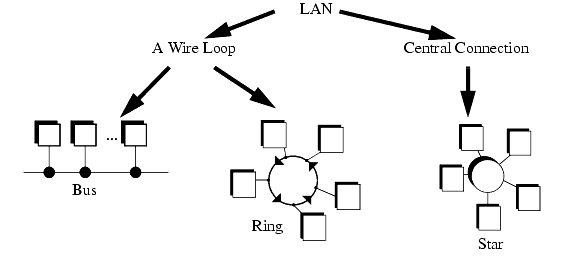
In the 'Ring' and 'Bus' topologies the network control is distributed between all of the computers on the network. The wiring only uses a single loop or run of wire. But, because there is only one wire, the network will slow down significantly as traffic increases. This also requires more sophisticated network interfaces that can determine when a computer is allowed to transmit messages. It is also possible for a problem on the network wires to halt the entire network.
The 'Star' topology requires more wire overall to connect each computer to an intelligent hub. But, the network interfaces in the computer become simpler, and the network becomes more reliable. Another term commonly used is that it is deterministic, this means that performance can be predicted. This can be important in critical applications.
For a factory environment the bus topology is popular. The large number of wires required for a star configuration can be expensive and confusing. The loop of wire required for a ring topology is also difficult to connect, and it can lead to ground loop problems. Figure 12.13 shows a tree topology that is constructed out of smaller bus networks. Repeaters are used to boost the signal strength and allow the network to be larger.
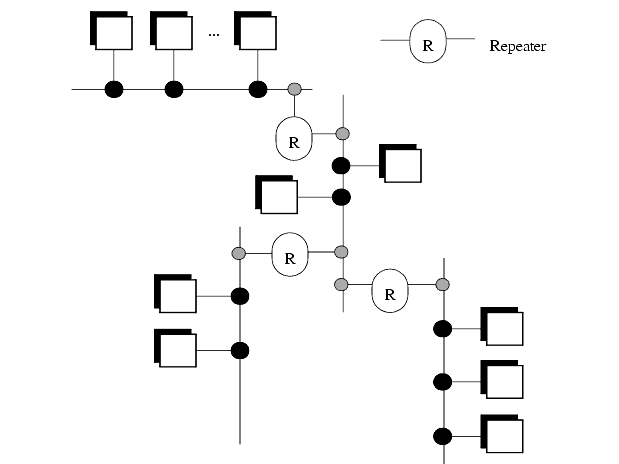
5.2.2 OSI Network Model
������������The Open System Interconnection (OSI) model in Figure 22.14 was developed as a tool to describe the various hardware and software parts found in a network system. It is most useful for educational purposes, and explaining the things that should happen for a successful network application. The model contains seven layers, with the hardware at the bottom, and the software at the top. The darkened arrow shows that a message originating in an application program in computer #1 must travel through all of the layers in both computers to arrive at the application in computer #2. This could be part of the process of reading email.
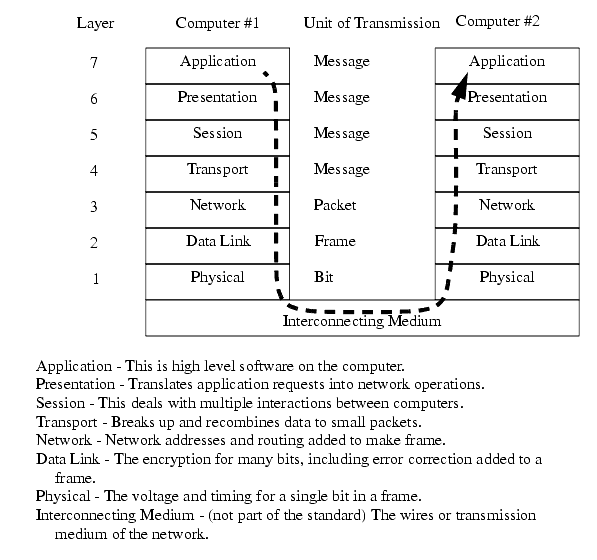
The 'Physical' layer describes items such as voltage levels and timing for the transmission of single bits. The 'Data Link' layer deals with sending a small amount of data, such as a byte, and error correction. Together, these two layers would describe the serial byte shown in Figure 22.3. The 'Network' layer determines how to move the message through the network. If this were for an internet connection this layer would be responsible for adding the correct network address. The 'Transport' layer will divide small amounts of data into smaller packets, or recombine them into one larger piece. This layer also checks for data integrity, often with a checksum. The 'Session' layer will deal with issues that go beyond a single block of data. In particular it will deal with resuming transmission if it is interrupted or corrupted. The 'Session' layer will often make long term connections to the remote machine. The 'Presentation' layer acts as an application interface so that syntax, formats and codes are consistent between the two networked machines. For example this might convert '\' to '/' in HTML files. This layer also provides subroutines that the user may call to access network functions, and perform functions such as encryption and compression. The 'Application' layer is where the user program resides. On a computer this might be a web browser, or a ladder logic program on a PLC.
Most products can be described with only a couple of layers. Some networking products may omit layers in the model. Consider the networks shown in Figure 22.15.
5.2.3 Networking Hardware
������������The following is a description of most of the hardware that will be needed in the design of networks.
Network Interface Hardware - The network interface may already be built into the computer/PLC/sensor/etc. These may cost $15 to over $1000.
10baseT (twisted pair) is the most popular. It is a pair of twisted copper wires terminated with an RJ-45 connector.
Repeaters (Physical Layer) - These accept signals and retransmit them so that longer networks can be built.
Hub/Concentrator - A central connection point that network wires will be connected to. It will pass network packets to local computers, or to remote networks if they are available.
Bridges (Data link layer) - These are intelligent devices that can convert data on one type of network, to data on another type of network. These can also be used to isolate two networks.
Gateway (Application Layer) - A Gateway is a full computer that will direct traffic to different networks, and possibly screen packets. These are often used to create firewalls for security.
Figure 22.15 shows the basic OSI model equivalents for some of the networking hardware described before.
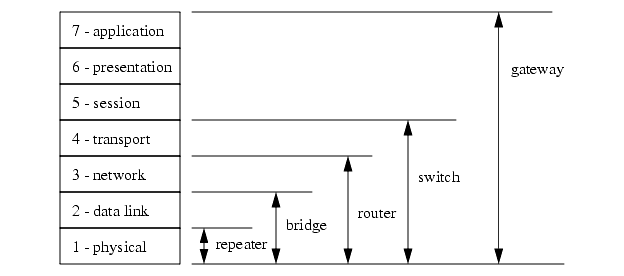
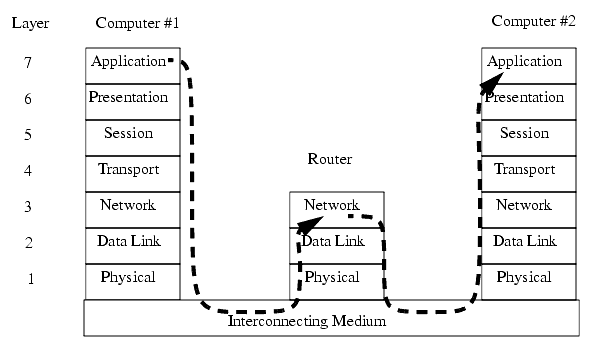
5.2.4 Control Network Issues
������������A wide variety of networks are commercially available, and each has particular strengths and weaknesses. The differences arise from their basic designs. One simple issue is the use of the network to deliver power to the nodes. Some control networks will also supply enough power to drive some sensors and simple devices. This can eliminate separate power supplies, but it can reduce the data transmission rates on the network. The use of network taps or tees to connect to the network cable is also important. Some taps or tees are simple 'passive' electrical connections, but others involve sophisticated 'active' tees that are more costly, but allow longer networks.
The transmission type determines the communication speed and noise immunity. The simplest transmission method is baseband, where voltages are switched off and on to signal bit states. This method is subject to noise, and must operate at lower speeds. RS-232 is an example of baseband transmission. Carrierband transmission uses FSK (Frequency Shift Keying) that will switch a signal between two frequencies to indicate a true or false bit. This technique is very similar to FM (Frequency Modulation) radio where the frequency of the audio wave is transmitted by changing the frequency of a carrier frequency about 100MHz. This method allows higher transmission speeds, with reduced noise effects. Broadband networks transmit data over more than one channel by using multiple carrier frequencies on the same wire. This is similar to sending many cable television channels over the same wire. These networks can achieve very large transmission speeds, and can also be used to guarantee real time network access.
The bus network topology only uses a single transmission wire for all nodes. If all of the nodes decide to send messages simultaneously, the messages would be corrupted (a collision occurs). There are a variety of methods for dealing with network collisions, and arbitration.
CSMA/CD (Collision Sense Multiple Access/Collision Detection) - if two nodes start talking and detect a collision then they will stop, wait a random time, and then start again.
CSMA/BA (Collision Sense Multiple Access/Bitwise Arbitration) - if two nodes start talking at the same time the will stop and use their node addresses to determine which one goes first.
Master-Slave - one device one the network is the master and is the only one that may start communication. slave devices will only respond to requests from the master.
Token Passing - A token, or permission to talk, is passed sequentially around a network so that only one station may talk at a time.
The token passing method is deterministic, but it may require that a node with an urgent message wait to receive the token. The master-slave method will put a single machine in charge of sending and receiving. This can be restrictive if multiple controllers are to exist on the same network. The CSMA/CD and CSMA/BA methods will both allow nodes to talk when needed. But, as the number of collisions increase the network performance degrades quickly.
5.2.5 Ethernet
������������Ethernet has become the predominate networking format. Version I was released in 1980 by a consortium of companies. In the 1980s various versions of ethernet frames were released. These include Version II and Novell Networking (IEEE 802.3). Most modern ethernet cards will support different types of frames.
The ethernet frame is shown in Figure 20.21. The first six bytes are the destination address for the message. If all of the bits in the bytes are set then any computer that receives the message will read it. The first three bytes of the address are specific to the card manufacturer, and the remaining bytes specify the remote address. The address is common for all versions of ethernet. The source address specifies the message sender. The first three bytes are specific to the card manufacturer. The remaining bytes include the source address. This is also identical in all versions of ethernet. The 'ethernet type' identifies the frame as a Version II ethernet packet if the value is greater than 05DChex. The other ethernet types use these to bytes to indicate the datalength. The 'data' can be between 46 to 1500 bytes in length. The frame concludes with a 'checksum' that will be used to verify that the data has been transmitted correctly. When the end of the transmission is detected, the last four bytes are then used to verify that the frame was received correctly.

5.2.6 SLIP and PPP
������������Ethernet connections are not always practical for computers at a distance, or when networking hardware is not available. A common alternative is to use a serial connection, such as a telephone modem. Network data packets are passed using a protocol such as Serial Line Internet Protocol (SLIP) and Point to Point Protocol (PPP).
At present the alternatives for data transfer are listed below. This is a short list, but it can be expected to grow quickly over time.
Phone lines with modem (dial up) - this runs at speeds up to 56Kbaud, with a peak data rate of about 3KB/sec. These are used for network connection that lasts from a few minutes to hours. This is very widespread and universally supported, but expect this 40 year old technology to be phased out over the next decade.
Direct serial connection - this can be done with a direct connection between serial ports on two computers using SLIP or PPP. The peak rates can reach over 6KB/sec. This method can also be done using a low speed radio modem.
Direct parallel connection - this is done by connecting the parallel ports on two computers together and using Parallel Line Interface Protocol (PLIP). Data rates approaching 1MB/sec are possible.
ISDN - Integrated Services Digital Network (ISDN) uses dedicated phone lines that require a special interface card. Data rates reach 56Kbaud, but lines can be added in parallel to increase the speed. These tend to be high cost and are less popular.
DSL - Digital Subscriber Line (DSL) - This technology uses an existing residential phone line, but at frequencies above the audio range. The network connection is always active, but telephone usage can be permitted at any time. These have a faster data transfer rate than dial up connections, but still have a higher cost.
Cable - These broadband networks provide a permanent network connection that uses existing cable television networks. Special networking hardware is required. These networks are notable because the download speeds is higher than the download speed.
Satellite - These connections are available at a high cost and are suitable for remote locations where other communications access is not possible.
Search for More: |

Custom Search
|

|